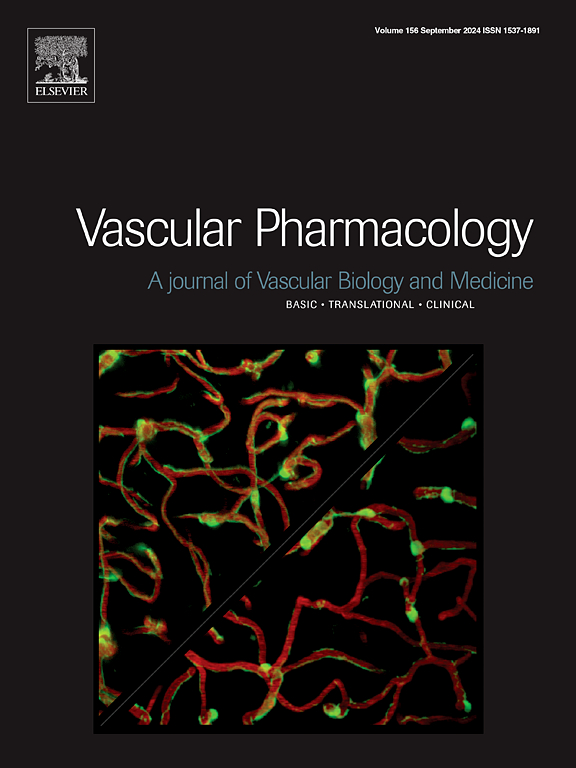巨噬细胞和心肌细胞在心脏保护中的作用:利用NLRP3炎性体抑制剂INF150。
IF 3.5
3区 医学
Q2 PHARMACOLOGY & PHARMACY
引用次数: 0
摘要
背景:心血管疾病仍然是西方世界致残和死亡的主要原因。有效的心脏保护包括限制缺血/再灌注损伤(IRI),包括NLRP3炎性体驱动的细胞死亡(焦亡)。虽然各种心脏常驻细胞群有助于心脏保护,但目前尚不清楚靶向常驻巨噬细胞是否具有固有的心脏保护作用。考虑到NLRP3抑制剂INF150表现出不同的穿透心肌细胞和巨噬细胞的能力,我们试图解决这个问题。方法:我们研究了NLRP3抑制剂INF195的有效代谢物INF150在离体心脏或细胞中的心脏保护潜力。在离体心脏中,我们测量了梗死面积、caspase-1切割和白介素(IL)释放,而在巨噬细胞、H9c2细胞和分化的H9c2中,我们分析了缺氧/再氧化(H/R)后的细胞活力和焦亡标志物,包括IL-1β释放和Gasdermin D切割。结果和结论:虽然INF150可以有效地保护巨噬细胞免受LPS/ATP的攻击,但即使在高浓度下,它也不能穿透H9c2并分化H9c2 (H/R诱导的焦亡标志物没有变化)。在离体小鼠心脏模型中,INF150没有显示出心脏保护作用:梗死面积、IL-1β、cleaved caspase-1水平在不同浓度的INF150中没有显著变化。这些发现表明,尽管INF150在巨噬细胞/吞噬模型中显示出前景,但其无法穿透心肌细胞限制了其在整个心脏组织中的有效性。我们的研究结果强调了心肌细胞摄取对有效心脏保护的重要性,强调了能够直接靶向这些细胞的NLRP3抑制剂的需求。未来的研究应侧重于增强NLRP3抑制剂的递送和心肌细胞摄取,以实现心脏保护。不像它的前体,能穿透H9c2细胞的INF195, INF150似乎不能在整个器官中提供心脏保护。本文章由计算机程序翻译,如有差异,请以英文原文为准。

Macrophage and cardiomyocyte roles in cardioprotection: Exploiting the NLRP3 Inflammasome inhibitor INF150
Background
Cardiovascular diseases remain the leading cause of disability and death in the Western world. Effective cardioprotection involves limiting ischemia/reperfusion injury (IRI), including cell death (pyroptosis) driven by the NLRP3 inflammasome. While various cardiac resident cellular populations contribute to cardioprotection, it remains unclear whether targeting resident macrophages is inherently cardioprotective. Given that INF150, an NLRP3 inhibitor, exhibits varying abilities to penetrate cardiomyocytes and macrophages, we sought to address this question.
Methods
We studied the cardioprotective potential of INF150, the potent metabolite of the NLRP3 inhibitor INF195, in isolated hearts or cells. In isolated hearts, we measured infarct size, caspase-1 cleavage, and interleukins (IL) release, while in macrophages, naïve H9c2 and differentiated H9c2 cells, we analyzed cell viability, and pyroptosis markers, including IL-1β release and Gasdermin D cleavage, following hypoxia/reoxygenation (H/R).
Results and conclusion
While INF150 effectively shielded macrophages from LPS/ATP challenges, it failed to penetrate H9c2 and differentiated H9c2, even at high concentrations (no changes in pyroptosis markers induced by H/R). In the isolated mice heart model, INF150 did not demonstrate cardioprotective effects: infarct size, IL-1β, cleaved caspase-1 levels did not change significantly across tested concentrations of INF150. These findings suggest that while INF150 shows promise in macrophage/phagocytic models, its inability to penetrate cardiomyocytes limits its effectiveness in the whole cardiac tissue. Our results underscore the importance of cardiomyocyte uptake for effective cardioprotection, highlighting the need for NLRP3 inhibitors capable of targeting these cells directly. Future research should focus on enhancing the delivery and cardiomyocyte uptake of NLRP3 inhibitors to achieve cardioprotection. Unlike its precursor, INF195, which penetrates H9c2 cells, INF150 does not appear to offer cardioprotection in the whole organ.
求助全文
通过发布文献求助,成功后即可免费获取论文全文。
去求助
来源期刊

Vascular pharmacology
医学-药学
CiteScore
6.60
自引率
2.50%
发文量
153
审稿时长
31 days
期刊介绍:
Vascular Pharmacology publishes papers, which contains results of all aspects of biology and pharmacology of the vascular system.
Papers are encouraged in basic, translational and clinical aspects of Vascular Biology and Pharmacology, utilizing approaches ranging from molecular biology to integrative physiology. All papers are in English.
The Journal publishes review articles which include vascular aspects of thrombosis, inflammation, cell signalling, atherosclerosis, and lipid metabolism.
 求助内容:
求助内容: 应助结果提醒方式:
应助结果提醒方式:


